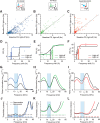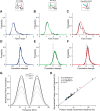Cortical Neural Activity Predicts Sensory Acuity Under Optogenetic Manipulation
- PMID: 29367406
- PMCID: PMC5824743
- DOI: 10.1523/JNEUROSCI.2457-17.2017
Cortical Neural Activity Predicts Sensory Acuity Under Optogenetic Manipulation
Abstract
Excitatory and inhibitory neurons in the mammalian sensory cortex form interconnected circuits that control cortical stimulus selectivity and sensory acuity. Theoretical studies have predicted that suppression of inhibition in such excitatory-inhibitory networks can lead to either an increase or, paradoxically, a decrease in excitatory neuronal firing, with consequent effects on stimulus selectivity. We tested whether modulation of inhibition or excitation in the auditory cortex of male mice could evoke such a variety of effects in tone-evoked responses and in behavioral frequency discrimination acuity. We found that, indeed, the effects of optogenetic manipulation on stimulus selectivity and behavior varied in both magnitude and sign across subjects, possibly reflecting differences in circuitry or expression of optogenetic factors. Changes in neural population responses consistently predicted behavioral changes for individuals separately, including improvement and impairment in acuity. This correlation between cortical and behavioral change demonstrates that, despite the complex and varied effects that these manipulations can have on neuronal dynamics, the resulting changes in cortical activity account for accompanying changes in behavioral acuity.SIGNIFICANCE STATEMENT Excitatory and inhibitory interactions determine stimulus specificity and tuning in sensory cortex, thereby controlling perceptual discrimination acuity. Modeling has predicted that suppressing the activity of inhibitory neurons can lead to increased or, paradoxically, decreased excitatory activity depending on the architecture of the network. Here, we capitalized on differences between subjects to test whether suppressing/activating inhibition and excitation can in fact exhibit such paradoxical effects for both stimulus sensitivity and behavioral discriminability. Indeed, the same optogenetic manipulation in the auditory cortex of different mice could improve or impair frequency discrimination acuity, predictable from the effects on cortical responses to tones. The same manipulations sometimes produced opposite changes in the behavior of different individuals, supporting theoretical predictions for inhibition-stabilized networks.
Keywords: auditory cortex; behavior; computational modeling; excitatory–inhibitory circuits; frequency discrimination; optogenetics.
Copyright © 2018 the authors 0270-6474/18/382094-12$15.00/0.
Figures








Similar articles
-
Diversity of Receptive Fields and Sideband Inhibition with Complex Thalamocortical and Intracortical Origin in L2/3 of Mouse Primary Auditory Cortex.J Neurosci. 2021 Apr 7;41(14):3142-3162. doi: 10.1523/JNEUROSCI.1732-20.2021. Epub 2021 Feb 16. J Neurosci. 2021. PMID: 33593857 Free PMC article.
-
Differential Short-Term Plasticity of PV and SST Neurons Accounts for Adaptation and Facilitation of Cortical Neurons to Auditory Tones.J Neurosci. 2020 Nov 25;40(48):9224-9235. doi: 10.1523/JNEUROSCI.0686-20.2020. Epub 2020 Oct 23. J Neurosci. 2020. PMID: 33097639 Free PMC article.
-
Attenuation of Responses to Self-Generated Sounds in Auditory Cortical Neurons.J Neurosci. 2016 Nov 23;36(47):12010-12026. doi: 10.1523/JNEUROSCI.1564-16.2016. J Neurosci. 2016. PMID: 27881785 Free PMC article.
-
Interplay of excitation and inhibition elicited by tonal stimulation in pyramidal neurons of primary auditory cortex.Neurosci Biobehav Rev. 2011 Nov;35(10):2084-93. doi: 10.1016/j.neubiorev.2010.11.009. Epub 2010 Dec 7. Neurosci Biobehav Rev. 2011. PMID: 21144861 Review.
-
Progress and challenges for understanding the function of cortical microcircuits in auditory processing.Nat Commun. 2017 Dec 18;8(1):2165. doi: 10.1038/s41467-017-01755-2. Nat Commun. 2017. PMID: 29255268 Free PMC article. Review.
Cited by
-
Dynamics of cortical contrast adaptation predict perception of signals in noise.Nat Commun. 2023 Aug 9;14(1):4817. doi: 10.1038/s41467-023-40477-6. Nat Commun. 2023. PMID: 37558677 Free PMC article.
-
Parvalbumin neurons enhance temporal coding and reduce cortical noise in complex auditory scenes.Commun Biol. 2023 Jul 19;6(1):751. doi: 10.1038/s42003-023-05126-0. Commun Biol. 2023. PMID: 37468561 Free PMC article.
-
Cell type-specific inhibitory modulation of sound processing in the auditory thalamus.bioRxiv [Preprint]. 2025 Mar 9:2024.06.29.601250. doi: 10.1101/2024.06.29.601250. bioRxiv. 2025. PMID: 38979223 Free PMC article. Preprint.
-
Distinct Inhibitory Neurons Differently Shape Neuronal Codes for Sound Intensity in the Auditory Cortex.J Neurosci. 2025 Jan 8;45(2):e1502232024. doi: 10.1523/JNEUROSCI.1502-23.2024. J Neurosci. 2025. PMID: 39516042 Free PMC article.
-
Neural Correlates of Learning Pure Tones or Natural Sounds in the Auditory Cortex.Front Neural Circuits. 2020 Jan 28;13:82. doi: 10.3389/fncir.2019.00082. eCollection 2019. Front Neural Circuits. 2020. PMID: 32047424 Free PMC article.
References
Publication types
MeSH terms
Grants and funding
LinkOut - more resources
Full Text Sources
Other Literature Sources
Molecular Biology Databases
Research Materials
